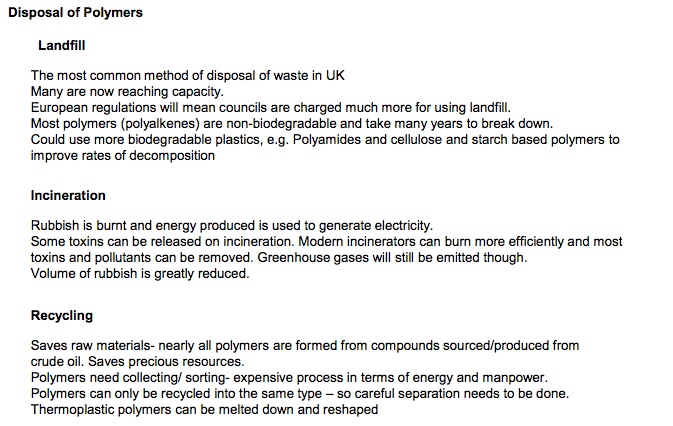


Disposal of Polymers Landfill The most common method of disposal of waste in UK Many are now reaching capacity. European regulations will mean councils are charged much more for using landfill. Most polymers (polyalkenes) are non-biodegradable and take many years to break down. Could use more biodegradable plastics, e.g. Polyamides and cellulose and starch based polymers to improve rates of decomposition Incineration Rubbish is burnt and energy produced is used to generate electricity. Some toxins can be released on incineration. Modern incinerators can burn more efficiently and most toxins and pollutants can be removed. Greenhouse gases will still be emitted though. Volume of rubbish is greatly reduced. Recycling Saves raw materials- nearly all polymers are formed from compounds sourced/produced from crude oil. Saves precious resources. Polymers need collecting/ sorting- expensive process in terms of energy and manpower. Polymers can only be recycled into the same type – so careful separation needs to be done. Thermoplastic polymers can be melted down and reshaped. polyesters and polyamides can be broken down by hydrolysis and are, therefore, biodegradable Polyesters can be hydrolysed by acid and alkali With HCl a polyester will be hydrolysed and split up in to the original dicarboxylic acid and diol With NaOH an polyester will be hydrolysed and split up into the diol and dicarboxylic acid salt. Polyamides can be hydrolysed by aqueous acids or alkalis. With HCl an polyamide will be hydrolysed and split up in to the original dicarboxylic acid and diamine salt With NaOH an polyamide will be hydrolysed and split up into the diamine and dicarboxylic acid salt Poly(alkenes) are chemically inert due to the strong C-C
and C-H bonds and non-polar nature of the bonds and
therefore are non-biodegradable.
and C-H bonds and non-polar nature of the bonds and
therefore are non-biodegradable.
/
~
~
~
/
3.3.12.2 Biodegradability and disposal of polymers (A-level only)
Polyalkenes are chemically inert and non-biodegradable.
Polyesters and polyamides can be broken down by hydrolysis and are biodegradable.
The advantages and disadvantages of different methods of disposal of polymers, including recycling.
Students should be able to explain why polyesters and polyamides can be hydrolysed but polyalkenes cannot.


 3.12 Polymers Page 3
3.12 Polymers Page 3 Oxford Textbook Pages : 454
Oxford Textbook Pages : 454







